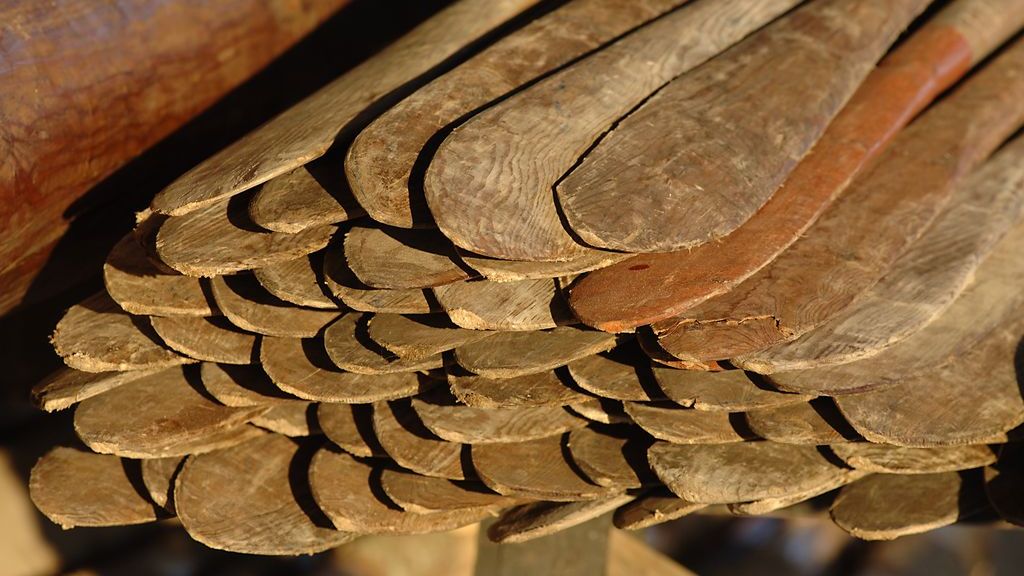On the 4th September 2004, Sea Stallion was named by Her Majesty Queen Margrethe and afterwards launched by its 60-strong cew.
Sea Stallion is celebrating its 10th birthday far from Roskilde. Today, the 4th September, the ship arrived in Berlin's harbour to prepare for the rowing trip through the city on Saturday 6th September and the Queen's visit with President Gauck on the 9th Spetember, in connection with the opening of the exhibition 'Die Wikinger' and the Viking Ship Museum's exhibition 'Ships of the Vikings' at Martin Gropius Bau.
On the 3rd September, Sea Stallion was lifted out of the water using two cranes, and placed on a flatbed truck to start the journey to Berlin. At 3:45pm, the heavy transport truck crossed the Farø bridges and at 8pm, the ship was driven on board the ferry 'Kronprins Fredrik' in Gedser.
Early on Thursday morning, Sea Stallion arrived to Berlin's West Hafen. The ship will lie here until Saturday, where the crew will go on board and row the ship through Berlin's centre.
See photos from Sea Stallion's voyages
To celebrate Sea Stallion's 10th birthday, we've gathered some of the most beautiful images from the ship's voyages.
With its length of 30m, Sea Stallion is the world's largest Viking ship reconstruction. The original ship - Skuldelev 2 - stands on display at the Viking Ship Hall together with four other ships, which were excavated near Skuldelev on Roskilde Fjord in 1962.
The ship became world famous when it undertook the spectacular trial voyage from Roskilde, north around Scotland to the Irish capital, Dublin, in 2007 and back to Roskilde, going south around the English coast in 2008. Along the way, the ship stopped at many harbours and it was possible to follow the sailing via a satellite map on the Viking Ship Museum's website. It was a huge communications success - 1.5 million people followed the voyage during its 14 week duration.
![[Translate to english:] Særtransport af verden længste rekonstruktion af et vikingeskib
[Translate to english:] Særtransport af verden længste rekonstruktion af et vikingeskib](/frontend/_processed_/e/e/csm_2014_09_03_12_38_36_WK_98bb1564f1.jpg)



![[Translate to english:] Vikingeskibsmuseets medarbejdere og de fremmødte tilskuere holdt vejret, da kranerne løftede det 30 meter lange krigsskib ud af Roskilde Havn.
[Translate to english:] Vikingeskibsmuseets medarbejdere og de fremmødte tilskuere holdt vejret, da kranerne løftede det 30 meter lange krigsskib ud af Roskilde Havn.](/frontend/_processed_/6/0/csm_2014_09_03_09_10_29_WK_229b0fb1e2.jpg)
![[Translate to english:] Det tog mindre end 10 minutter at få skibet placeret på blokvognen.
[Translate to english:] Det tog mindre end 10 minutter at få skibet placeret på blokvognen.](/frontend/_processed_/9/1/csm_2014_09_03_09_10_32_WK_0e1a6b87e4.jpg)
![[Translate to english:] der var tid til at vaske skibet rent for alger, så det kan fremstå smukt i Berlin.
[Translate to english:] der var tid til at vaske skibet rent for alger, så det kan fremstå smukt i Berlin.](/frontend/_processed_/c/1/csm_2014_09_03_09_46_34_WK_3412e6d1cb.jpg)
![[Translate to english:] Inden lastbilen kunne rulle af sted, blev stropper og kiler strammet, sikret og tjekket.
[Translate to english:] Inden lastbilen kunne rulle af sted, blev stropper og kiler strammet, sikret og tjekket.](/frontend/_processed_/4/6/csm_2014_09_03_12_20_30_WK_7f09c63ad9.jpg)
![[Translate to english:] Første del af en kompliceret rejse. Havhingsten blev forsigtigt kørt ud på den smalle Havnevej for at sætte kursen mod syd.
[Translate to english:] Første del af en kompliceret rejse. Havhingsten blev forsigtigt kørt ud på den smalle Havnevej for at sætte kursen mod syd.](/frontend/_processed_/e/e/csm_2014_09_03_12_38_36_WK_e92a7becf0.jpg)
![[Translate to english:] I Gedser ventede Havhingsten på færgen til stor glæde for de ventende biler.
[Translate to english:] I Gedser ventede Havhingsten på færgen til stor glæde for de ventende biler.](/frontend/_processed_/a/b/csm_Berlintransport_FerryII_d13570735d.jpg)
![[Translate to english:] Kl. 20.00 blev skibet kørt om bord på færgen - nu venter eventyret i Berlin. [Translate to english:] Kl. 20.00 blev skibet kørt om bord på færgen - nu venter eventyret i Berlin.](/frontend/_processed_/1/3/csm_Berlintransport_Ferry_f885a3d563.jpg)